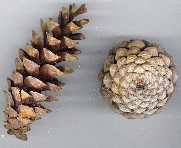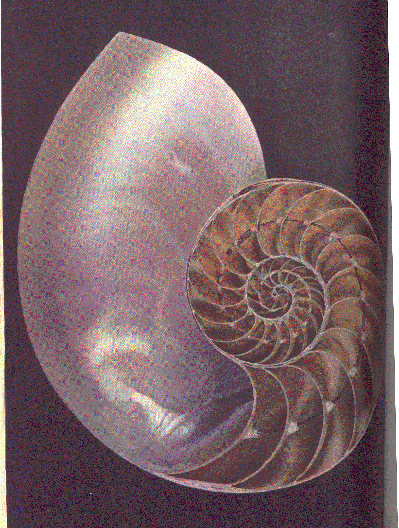For instance, the florets in the head of a sunflower form two oppositely directed spirals: 55 of them clockwise and 34 counterclockwise. Surprisingly, these numbers are consecutive Fibonacci Numbers. The ratios of alternate Fibonacci Numbers are given by the convergents to f-2, where f is the Golden Ratio, convergenta said to measure the fraction of a turn between successive leaves on the stalk of a plant: 1/2 for elm and linden, 1/3 for beech and hazel, 2/5 for oak and apple, 3/8 for poplar and rose, 5/13 for willow and almond, etc. A similar phenomenon occurs for Daisies, pineapples, pinecones, cauliflowers, and so on.
Lilies, irises, and the trillium have three petals; columbines, buttercups, larkspur, and wild rose have five petals; delphiniums, bloodroot, and cosmos have eight petals; corn marigolds have 13 petals; asters have 21 petals; and daisies have 34, 55, or 84 petals--all Fibonacci Numbers.
A figure resembling a daisy or sunflower in which copies of a geometric figure of increasing size are placed at regular intervals along a spiral. The resulting figure appears to have multiple spirals spreading out from the center.
 This is THE LOGARITHMIC SPIRAL, which occurs in pine cones. Rotation through
the most irrational angle leads to seed packing patterns with numbers of left- and right-diagonal rows given by consectutive Fibonacci numbers: (3,5) and (5,8) for the two pine cones shown here.
This is THE LOGARITHMIC SPIRAL, which occurs in pine cones. Rotation through
the most irrational angle leads to seed packing patterns with numbers of left- and right-diagonal rows given by consectutive Fibonacci numbers: (3,5) and (5,8) for the two pine cones shown here.
 This spiral is also the design of the chambered nautilus, akin to the octupus, but the only cephalopod to have an external
shell.
This spiral is also the design of the chambered nautilus, akin to the octupus, but the only cephalopod to have an external
shell.